RESULTS
Results of this study are presented in
Figures 4,
5,
6,
7, and
8 and
Tables 1,
2,
3,
4,
5, and
6. These illustrate changes in some aspects of
occlusal morphology with wear and identify other attributes that may not change
in a consistent manner as a tooth wears. These results use teeth of different
specimens to create a model of an occlusal wear sequence for the taxon. Although
the scaling, alignment, and cropping procedures described above minimize
differences between specimens, we must remember that individual variation can
still complicate wear sequence patterns (see
Discussion). Each attribute can be
considered individually.
Slope
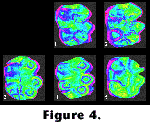 Slope
is one measure of topographic relief of the occlusal surface. Although one might
expect to observe a consistent decrease in mean slope as cusps become more worn,
this pattern is obscured by dentin exposure, and resulting steeply walled pits
(Figure 4; Table 1). There
is a general decrease in slopes for all cusps between the first and the fifth
wear stages. Further, four of five cusps show decreasing slope values between
stages 1 and 2 and between stages 4 and 5. On the other hand, only three cusps
show decreasing values between stages 2 and 3, and two show decreasing values
between wear stages 3 and 4.
Slope
is one measure of topographic relief of the occlusal surface. Although one might
expect to observe a consistent decrease in mean slope as cusps become more worn,
this pattern is obscured by dentin exposure, and resulting steeply walled pits
(Figure 4; Table 1). There
is a general decrease in slopes for all cusps between the first and the fifth
wear stages. Further, four of five cusps show decreasing slope values between
stages 1 and 2 and between stages 4 and 5. On the other hand, only three cusps
show decreasing values between stages 2 and 3, and two show decreasing values
between wear stages 3 and 4.
Delta Slope
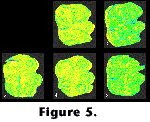 The
rate of change of slope is an indicator of the angularity of a surface, with
high numbers representing sharper edges. There is no pattern of increasing or
decreasing change in slope between adjacent wear stages (Figure
5; Table 2). There is also no pattern evident
between the least and the most worn specimens. Therefore, there is no consistent
change in the angularity of the surface for each cusp. This may be related to
enamel penetrance and steeply angled dentin island walls for each of the cusps,
although more work needs to be done to confirm this relationship.
The
rate of change of slope is an indicator of the angularity of a surface, with
high numbers representing sharper edges. There is no pattern of increasing or
decreasing change in slope between adjacent wear stages (Figure
5; Table 2). There is also no pattern evident
between the least and the most worn specimens. Therefore, there is no consistent
change in the angularity of the surface for each cusp. This may be related to
enamel penetrance and steeply angled dentin island walls for each of the cusps,
although more work needs to be done to confirm this relationship.
Surface Area
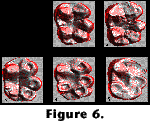 Surface
area of the cusps is calculated using the two-dimensional x-y area and slope
data. We would predict a general decrease in surface area as slope decreases
and tooth surface is worn away. Results indicated that patterns for the buccal
cusps (the protoconid, hypoconid and hypoconulid) and lingual cusps (the metaconid
and entoconid) differ (Figure 6; Table
3). As expected, the surface areas of the buccal cusps show a general decrease
through the wear sequence, with the lowest values seen at wear stage 5. On the
other hand, there is no such pattern for the lingual cusps. This may reflect
the fact that, in these primates, buccal cusps of lower molars wear much more
rapidly than do lingual cusps. In fact, lingual shearing crests on gorilla lower
molars can preserve much of their length well after the buccal cusp morphology
has begun to wear away.
Surface
area of the cusps is calculated using the two-dimensional x-y area and slope
data. We would predict a general decrease in surface area as slope decreases
and tooth surface is worn away. Results indicated that patterns for the buccal
cusps (the protoconid, hypoconid and hypoconulid) and lingual cusps (the metaconid
and entoconid) differ (Figure 6; Table
3). As expected, the surface areas of the buccal cusps show a general decrease
through the wear sequence, with the lowest values seen at wear stage 5. On the
other hand, there is no such pattern for the lingual cusps. This may reflect
the fact that, in these primates, buccal cusps of lower molars wear much more
rapidly than do lingual cusps. In fact, lingual shearing crests on gorilla lower
molars can preserve much of their length well after the buccal cusp morphology
has begun to wear away.
Relief Index
We developed a relief index to provide a more direct measure of occlusal relief
than could be obtained by examining surface area alone. This is a ratio of the
three-dimensional surface area to the two-dimensional x-y area. The greater the
occlusal relief, the higher the relief index. As expected, all five cusps show a
trend toward decreasing relief from stage 1 through stage 5 (
Figure 6;
Table 4), although there is some variability. Also as
expected, the decrease in relief is greatest on the buccal side of the crown.
Topographic Aspect
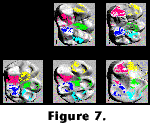 The
measurement of aspect offers intriguing possibilities for observing functional
changes of cusps though the wear sequence. It may be possible to assess changes
in occlusal relationships between upper and lower teeth by observing variation
in modal aspect (Table 5). The colors in Figure
7 relate to modal aspect increment for each cusp, not to particular aspect
direction. Perhaps the most obvious change in these data is on the buccal cusps
between the fourth and fifth stages, where the prevailing aspect switches by
180 degrees! This may indicate a decreased effectiveness of the tooth as a guide
for chewing motions ( Kay
and Hiiemae 1974). Still, a combined study of maxillary and mandibular dentitions
will be necessary to evaluate the potential of this approach.
The
measurement of aspect offers intriguing possibilities for observing functional
changes of cusps though the wear sequence. It may be possible to assess changes
in occlusal relationships between upper and lower teeth by observing variation
in modal aspect (Table 5). The colors in Figure
7 relate to modal aspect increment for each cusp, not to particular aspect
direction. Perhaps the most obvious change in these data is on the buccal cusps
between the fourth and fifth stages, where the prevailing aspect switches by
180 degrees! This may indicate a decreased effectiveness of the tooth as a guide
for chewing motions ( Kay
and Hiiemae 1974). Still, a combined study of maxillary and mandibular dentitions
will be necessary to evaluate the potential of this approach.
Basin Volume
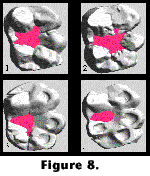 The
last variable to consider is central basin volume. We expected that as a tooth
wears, the basin volume would increase gradually because the worn cusps should
allow more fluid to accumulate before flowing off the molar. Instead, we saw
an increase in volume between stage 1 and stage 2, followed a sharp decrease
through stages three and four (Figure 8; Table
6). Due to the extreme wear seen in stage 5, the basin actually flowed right
over the buccal cusps, preventing useful measurement.
The
last variable to consider is central basin volume. We expected that as a tooth
wears, the basin volume would increase gradually because the worn cusps should
allow more fluid to accumulate before flowing off the molar. Instead, we saw
an increase in volume between stage 1 and stage 2, followed a sharp decrease
through stages three and four (Figure 8; Table
6). Due to the extreme wear seen in stage 5, the basin actually flowed right
over the buccal cusps, preventing useful measurement.

 Slope
is one measure of topographic relief of the occlusal surface. Although one might
expect to observe a consistent decrease in mean slope as cusps become more worn,
this pattern is obscured by dentin exposure, and resulting steeply walled pits
(Figure 4; Table 1). There
is a general decrease in slopes for all cusps between the first and the fifth
wear stages. Further, four of five cusps show decreasing slope values between
stages 1 and 2 and between stages 4 and 5. On the other hand, only three cusps
show decreasing values between stages 2 and 3, and two show decreasing values
between wear stages 3 and 4.
Slope
is one measure of topographic relief of the occlusal surface. Although one might
expect to observe a consistent decrease in mean slope as cusps become more worn,
this pattern is obscured by dentin exposure, and resulting steeply walled pits
(Figure 4; Table 1). There
is a general decrease in slopes for all cusps between the first and the fifth
wear stages. Further, four of five cusps show decreasing slope values between
stages 1 and 2 and between stages 4 and 5. On the other hand, only three cusps
show decreasing values between stages 2 and 3, and two show decreasing values
between wear stages 3 and 4. 


